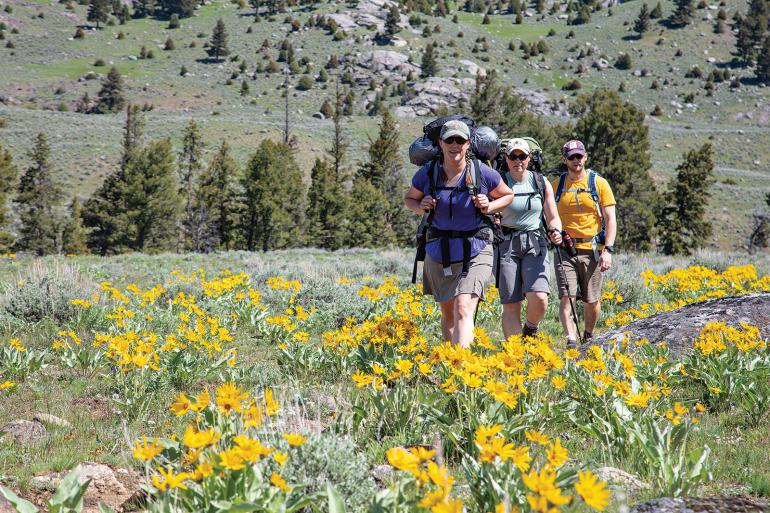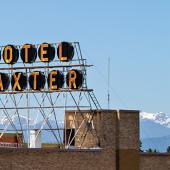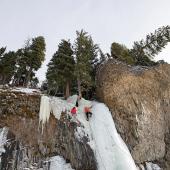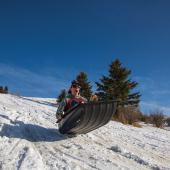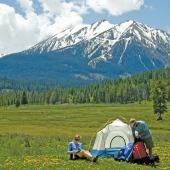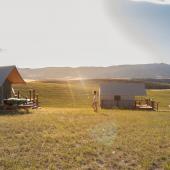Sleepin' Around
Spending a night in the woods.
There’s nothing quite like sleeping under the stars with the sounds of crickets singing in the background, or drinking your morning coffee overlooking a ridgeline or high-alpine lake. From towering peaks to riverbanks, southwest Montana overflows with areas to lay your head outdoors—for both the novice camper and seasoned backpacker. So, pack your bags (and bear spray) and venture out to unplug. There’s an endless amount to see.
Do Your Research
Waking up at your camp spot is part of the magic, but so is finding the spot to begin with. If you go to the first place you find from a Google search, props to you—but don’t be surprised if you’re not the only one with that idea. Get to know the landscape by doing research and becoming intimate with the different types of public lands.
U.S. Forest Service land, managed by the Department of Agriculture, typically offers dispersed (read: camp where you want) camping opportunities with and without amenities, allowing for a more choose-your-own-adventure type of experience. BLM (Bureau of Land Management) land, under the Department of the Interior, also offers dispersed camping—but is known for its wide-open spaces and fewer regulations, catering to those seeking solitude and more primitive camping. State Parks, managed by Montana Fish, Wildlife & Parks (FWP), generally provide more developed camping facilities such as designated campsites, water spigots, and restrooms, making them more family-friendly and structured. Fishing Access Sites, also managed by FWP, offer simple camping near area rivers and lakes, and many provide restrooms and designated campsites.
It’s helpful to make plans B and C for your camp spot, in the instance that your first or second choices are occupied.
Regardless of which you choose, be sure to pick a destination that matches your experience level and the desired difficulty of everyone on the trip. If you’re backpacking, is the trail physically accommodating to all on the trip? If car camping, do you need a high-clearance vehicle to access the campsite? Research the area thoroughly, understanding the trail maps and routes. Check for any necessary permits or regulations, and ensure that you are allowed to be there.
Furthermore, it’s helpful to make plans B and C for your camp spot, in the instance that your first or second choices are occupied. Montana’s weather can also vary by the hour, so it never hurts to peek at the weather forecast before heading out. Finally, always inform someone about your itinerary and expected return.
Essential Gear & Equipment
Lack of the proper gear can quickly turn your long-awaited camping trip turn into a nightmarish endeavor. Some must-have items include a quality tent and rainfly, a sleeping bag appropriate for the season, a sleeping pad for comfort and insulation, a portable stove, cooking utensils, a water filtration system, and bear spray (each individual on the trip should have a canister). Be sure to have clothing and shoes suitable for the weather and elements, and a way to keep it all dry if you get caught up in a rainstorm. A tarp, raincoat, or even spare trash bags will all do the trick.
It’s also beneficial to bring along a first-aid kit, soap or hand sanitizer, navigation tools, a headlamp, and a multi-purpose tool or knife. If you’re car camping or have weight to spare in your backpack, this list could become as extensive and glorious as you desire. Reviewing a checklist before your departure into the backcountry can ensure you don’t forget any critical items and help you pack efficiently.
At Camp
Great, you’ve arrived at camp! Now let’s make sure you leave it in the same state, if not better, than when you found it. When setting up your tent, look for a flat, sheltered area that is not too close to water—streams often rise at night from afternoon rainshowers or alpine snowmelt.
Pitch your tent on a durable surface and use a groundsheet to protect the tent floor. If you’re planning to have a group campfire, follow local regulations and practice fire safety. Properly dispose of waste (pack it in, pack it out!) and store food securely to avoid attracting wildlife. Avoid walking off the established trails at campsites to minimize your impact on the area.
Better Safe Than Sorry
A well-stocked first-aid kit complete with emergency medications is great to have on a trip, but by taking mindful precautions, you could likely avoid using it all together. As simple as it sounds, make sure to stay hydrated to combat the heat and elevation.
Having someone on the trip that knows basic first-aid procedures is ideal, and it is wise to review allergies with the group. It’s also helpful to be familiar with basic flora and fauna, as to make sure no one goes frolicking through a shrub of poison ivy or into the fangs of a rattlesnake.
Bear safety is a major precaution in southwest Montana as well. You’re in their home, after all. The camp kitchen and suspended food storage with all scented items (yep, toothpaste, lip balm, and that granola bar from the bottom of your backpack) should be at least 200 feet from your sleeping quarters.
Now that you’re all up to speed on research and safety, don’t forget to have fun and enjoy these beautiful landscapes we get to call home—from the comfort of a tent, that is.



